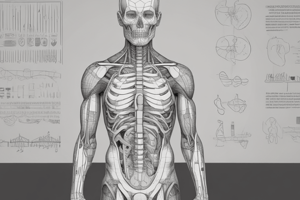Podcast
Questions and Answers
Which bones are found in the lower limbs?
Which bones are found in the lower limbs?
- Femur, Tibia, Fibula (correct)
- Tarsals, Metatarsals, Phalanges (correct)
- Humerus, Ulna, Radius
- Carpals, Metacarpals, Phalanges
Which bones are found in the wrist?
Which bones are found in the wrist?
- Carpals (correct)
- Metacarpals
- Tarsals
- Metatarsals
Which bone is part of the upper arm?
Which bone is part of the upper arm?
- Humerus (correct)
- Femur
- Radius
- Ulna
Which bone is found in the knee?
Which bone is found in the knee?
Which of these bones are found in the skull?
Which of these bones are found in the skull?
Flashcards
Skull
Skull
The bony structure that encases the brain; also known as the cranium.
Clavicle
Clavicle
The collarbone; connects the arm to the body.
Humerus
Humerus
The upper arm bone; extends from the shoulder to the elbow.
Femur
Femur
Signup and view all the flashcards
Pelvis
Pelvis
Signup and view all the flashcards
Study Notes
Bones
- Skull or Cranium: The bony structure that forms the head.
- Mandible: The lower jawbone.
- Clavicle: The collarbone.
- Scapula: The shoulder blade.
- Humerus: The upper arm bone.
- Sternum: The breastbone.
- Spine: The series of vertebrae that form the backbone.
- Ribs: The curved bones that protect the chest cavity.
- Radius: A bone in the forearm.
- Sacrum: A triangular bone at the base of the spine.
- Ulna: A bone in the forearm.
- Coccyx: The tailbone.
- Carpals: Small bones in the wrist.
- Metacarpals: Bones in the palm of the hand.
- Phalanges: The bones in the fingers and toes.
- Pelvis or Hip Bone: A group of bones that form the pelvis.
- Femur: The thigh bone.
- Patella: The kneecap.
- Fibula: A smaller lower leg bone.
- Tarsals: Small bones in the ankle.
- Tibia: The larger lower leg bone.
- Metatarsals: Bones in the foot.
Muscels
-
Adductors: Muscles that draw a limb toward the midline of the body.
-
Biceps Brachii: Muscle in the upper arm, responsible for bending the elbow.
-
Biceps Femoris: A muscle in the thigh, involved in hip extension and knee flexion.
-
Brachialis: Muscle in the upper arm, helps bend the elbow.
-
Brachioradialis: Muscle in the forearm, helps bend the elbow.
-
Deltoid: Muscle of shoulder, involved in abduction (lifting the arm).
-
Extensors: Muscles involved in straightening or extending a limb.
-
Flexors: Muscles that bend a limb.
-
Gastrocnemius: Muscle of the calf, involved in plantar flexion.
-
Gluteus Maximus: The largest buttock muscle, responsible for hip extension.
-
Gluteus Medius: Muscle in the buttock; hip abduction and internal rotation.
-
Gracilis: Muscle that helps adduct and flex the thigh.
-
Hamstrings: Muscle group at the back of the thigh, involves hip extension and knee flexion.
-
Infraspinatus: Muscle that is part of the rotator cuff; shoulder external rotation and abduction.
-
Latissimus Dorsi: Large muscle of the back, responsible for arm extension, adduction, and medial rotation.
-
Obliques: Muscles along the sides of the abdomen, involved in twisting and bending.
-
Pectoralis Major: Large chest muscle, involved in arm adduction, flexion, and horizontal adduction.
-
Quadriceps: Muscle group at front of the thigh, responsible for knee extension.
-
Rectus Abdominis: Muscle running vertically down the abdomen, responsible for flexion of the torso.
-
Rectus Femoris: Muscle of the quadriceps, involves hip flexion and knee extension.
-
Sartorius: Muscle that runs diagonally across the thigh, responsible for hip flexion, abduction, and external rotation.
-
Semimembranosus: Thigh muscle that helps with knee flexion and hip extension
-
Semitendinosus: Thigh muscle involved in hip extension and knee flexion.
-
Serratus Anterior: Muscle that helps stabilize the scapula.
-
Soleus: A muscle in the calf. Responsible for plantar flexion (pointing toes).
-
Sternocleidomastoid: Muscle involved in neck flexion and rotation.
-
Tensor Fasciae Latae: Muscle in the thigh; hip abduction.
-
Teres Major: Muscle in the back, responsible for shoulder adduction, extension, and medial rotation.
-
Teres Minor: Muscle of the rotator cuff; shoulder external rotation and abduction.
-
Tibialis Anterior: Muscle involved in ankle dorsiflexion and inversion.
-
Trapezius: Large muscle of the upper back (neck, shoulders, back)
-
Triceps Brachii: Muscle in the upper arm; elbow extension.
-
Vastus Lateralis: Muscle of quadriceps; knee extension
-
Vastus Medialis: Muscle of the quadriceps group, functions in extending the knee joint and stabilizing the patella.
Studying That Suits You
Use AI to generate personalized quizzes and flashcards to suit your learning preferences.




